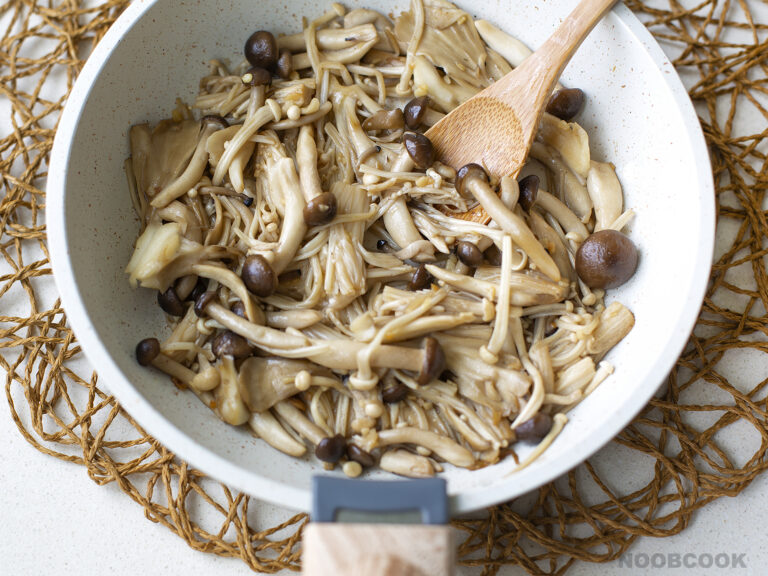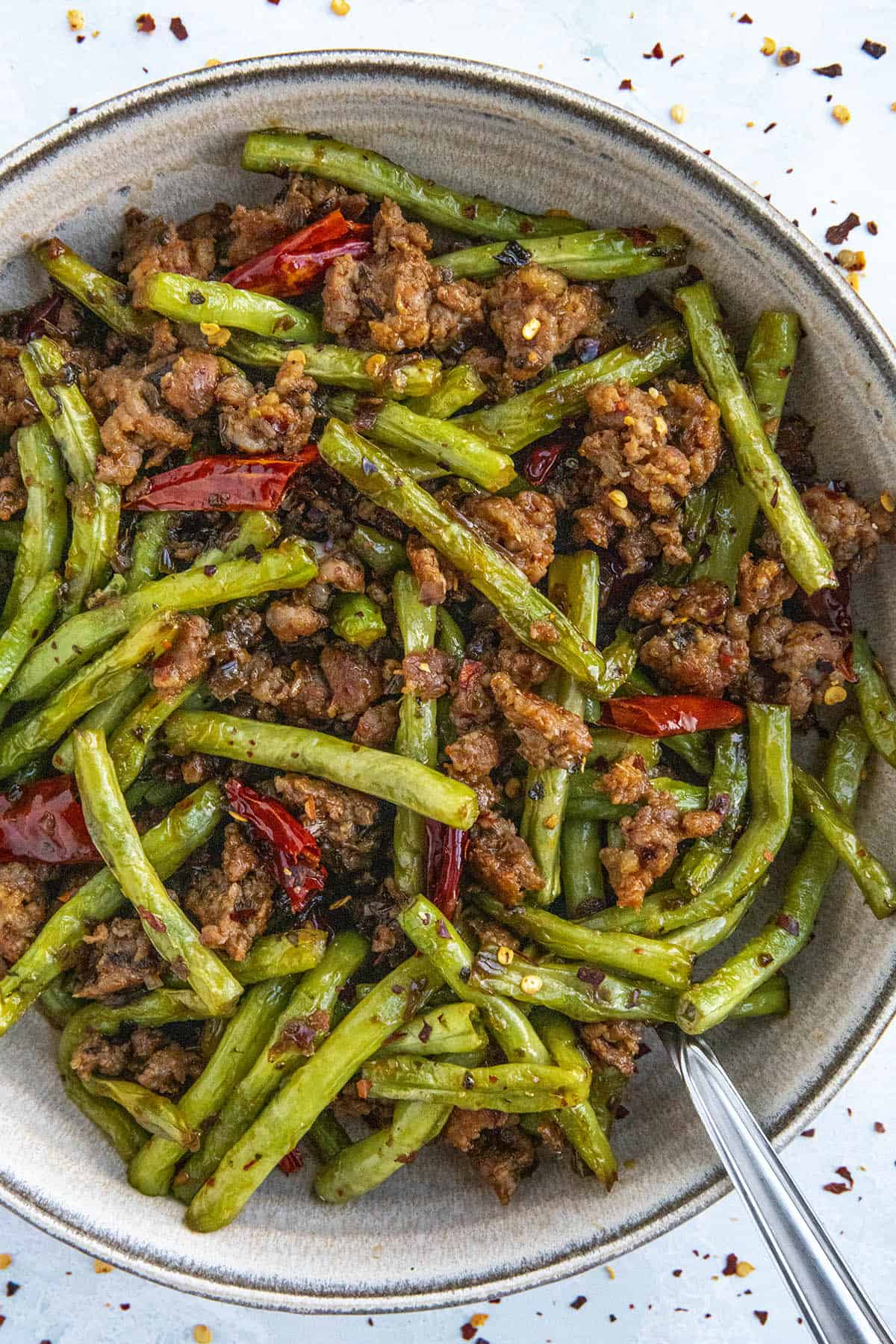Welcome to DU!
The truly grassroots left-of-center political community where regular people, not algorithms, drive the discussions and set the standards.
Join the community:
Create a free account
Support DU (and get rid of ads!):
Become a Star Member
Latest Breaking News
Editorials & Other Articles
General Discussion
The DU Lounge
All Forums
Issue Forums
Culture Forums
Alliance Forums
Region Forums
Support Forums
Help & Search
Cooking & Baking
Related: About this forumA Trio From Fuschia Dunlop 🌞

STIR-FRIED MIXED MUSHROOMS
shan zhen hui
l When I paid a late summer visit to the Wolong Nature Reserve
in western Sichuan, I discovered that one of the local cooks was,
like me, a former student of the Sichuan Institute of Higher Cui-
sine in Chengdu. In China this "same-school" (tong xue) bond is an
important one, and I was immediately taken in as one of the family.
My tong xue Peng Rui and I pottered around in the kitchen
while his mother smoked bacon over a smoldering fire in the
shed at the back. The highlight of the visit, however, was a trip we made up
the valley in search of wild food plants.
We chugged up the road on a borrowed moped, the immense, pine-clad
mountains rising steeply on either side, their peaks shrouded in drifting mists.
Through the center of the valley wound a rushing peacock-blue river, tumbling
over a mass of boulders. Small-scale farmers were carving out their livings on
the steep lower slopes, creating a beautiful patchwork of tiny plots. Dark
leaves flowered out around the hearts of cabbages, pinky-white radish tops
swelled out of the earth, yellow corn cobs and scarlet chiles dangled in
enormous bundles from the wooden eaves of scattered stone cottages.
At one point we left the road and went on foot up a craggy gorge where
cataracts spilled down into a mountain stream. Here, the changing seasons
brought wild walnuts and crabapples, tiny wild strawberries, and an
abundance of wild fungi.
The following recipe is created in homage to a dish of stir-fried wild
mushrooms that Peng Rui made that night. The fungi are cooked with
chicken fat, a Chinese luxury that gives them an exquisite richness
without actually recalling the taste of chicken. The other flavorings are
simple and colorless, allowing you to appreciate the variety and natural
subtlety of the fungi. You can vary the mushrooms as you will—just try
to bring together a few contrasting colors and textures.
Serves 4 with three other dishes
about a pound of mixed mushrooms: shiitake,
oyster, Chinese golden needle, Japanese enoki, or button
2 plump cloves of garlic
2 tablespoons peanut oil
3 tablespoons chicken fat or lard
1/3 cup chicken stock
1 12 teaspoon salt to taste
3/4 teaspoon cornstarch mixed with 2 teaspoons water
1 If you are using enoki mushrooms, make sure you pull them gently apart so
they don't stay in one clump. Cut all the other mushrooms into thickish
slices (about 1/4 inch). Thinly slice the garlic.
2 Heat the oil and chicken fat or lard in a wok over a high flame until just
smoking. Add the garlic and stir-fry briskly until it is fragrant and on the
verge of browning. Throw in all the mushrooms except for the enoki and
stir-fry for about 2 minutes. Then add the enoki and continue to stir-fry
until all the mushrooms are tender—another minute or so.
3 Pour in the stock and season with salt to taste. Bring to a boil, simmer for
a few seconds, and then add the cornstarch mixture and stir until it has
gently thickened the sauce. Transfer onto a plate and serve.
********************************************************************************

DRY-FRIED GREEN BEANS I
gan bian si ji dou
This is one of Sichuan's most famous vegetable dishes. The green
beans are traditionally dry-fried over a medium heat until they
are tender and slightly wrinkled, although these days most restaurants
deep-fry them to reduce the cooking time. If you want to
minimize the oiliness, you can steam or boil the beans to cook
them through instead of frying them, and then follow the rest of
the recipe (from step 3) according to the instructions given
below. This method is not authentic, but the results are delicious,
particularly for the vegetarian version of the dish.
Serves 4 with three other dishes
1 ounces haricots verts or green beans
peanut oil
3 ounces ground pork (about 2/3 cup)
2 teaspoons Shaoxing rice wine or medium-dry sherry
2 teaspoons soy sauce
2 tablespoons Sichuanese ya cai orTianjin preserved vegetable finely chopped
salt to taste
1 teaspoon sesame oil
1 Remove any strings from the edges of the beans and trim off the tops and
tails. Break them into short sections (about 2 inches long).
2 Heat 2 tablespoons of oil in a wok, add the beans, and stir-fry over a
medium flame for about 6 minutes, until they are tender and their skins
are a little puckered. Remove from the wok and set aside. (If you want
to save time, deep-fry the beans at about 350°F until they are tender and
puckered.)
3 Heat another 2 tablespoons of oil in the wok over a high flame, add the
pork, and stir-fry for 30 seconds or so until it's cooked, splashing in the
Shaoxing rice wine and the soy sauce as you go.
4 Add the ya cai or Tianjin preserved vegetable and stir-fry briefly until hot,
then toss in the beans. Stir and toss, adding salt to taste (remember that
the ya cai is already very salty).
5 Remove from the heat, stir in the sesame oil, and serve.
VARIATION
One restaurant I know In Chengdu cooks a similar dish with bitter melon,
which is sensational. The melon is deseeded and cut into thin strips and
then fried in the same way as the beans, until the strips are tender and
slightly wrinkly.
The final frying is exactly the same as in the recipe above, although they
do add a few dried chiles and a couple of lengths of scallion, white and
green parts.
***********************************************************

ANTS CLIMBING A TREE
(BEAN THREAD NOODLES WITH MINCED MEAT)
ma yi shang shu
If you dangle a few strands of these noodles from your chop-
sticks, tiny morsels of meat will cling to them "like ants climbing
a tree." This is an economical and hearty dish, typical of
Sichuanese home cooking and modest restaurants, but it's tasty
and attractive—a great interlaced mound of glassy noodles dotted
with ground meat, flakes of scarlet chile, and tiny rings of green
scallion. Some cooks deep-fry the dried noodles instead
m of soaking them, to delicious effect. The noodles do, however,
tend to disintegrate with that method. These noodles, which are
made from pea or mung bean starch, are readily available in Asian
food stores.
Serves 4 with two other dishes
1/4 pound bean thread noodles
1 teaspoon Shaoxing rice wine or medium-dry sherry
salt
1/4 pound ground pork or beef
peanut oil
3 teaspoons light soy sauce
1 1/2 tablespoon chile bean paste
1 2/3 cups chicken stock
1/2 teaspoon dark soy sauce
3 scallions, green parts only, finely sliced
1 Soak the noodles in hot water for at least 15 minutes before you begin
(drain them just before cooking). Add the Shaoxing rice wine and a couple
of generous pinches of salt to the ground meat and mix well.
2 Season the wok, then add 2 tablespoons of oil and heat over a high flame.
Add the ground meat and stir-fry until lightly browned and crispy, with a
teaspoon or so of light soy sauce. Add the chili bean paste and stir-fry until
the oil is red and fragrant, taking care not to burn it (remove the wok from
the heat for a few moments if it becomes too hot). Add the stock and the
drained noodles and stir well. Tip in the dark soy sauce for color, and season with light soy sauce and salt to taste.
3 When the stock has come to a boil, simmer over a medium flame for about
10 minutes, until the liquid has mostly evaporated and been absorbed.
Finally, add the scallions, mix well, and transfer to a serving dish.
All the above from "Land Of Plenty"
https://www.goodreads.com/book/show/94561.Land_of_Plenty
Fuschia has the goods on Sichuan food! Enjoy!